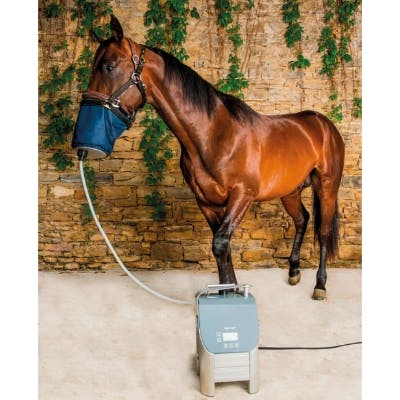An innovative approach to horse oxygenation

Commonly used for humans, the Bol d’air method aims to improve vitality and the ability to resist oxidative stress. Through technical and ergonomic adaptation, the Bol d’air Equin makes it accessible for horses.
The Landes forest at the heart of your stable
You should know that this variety of maritime pine (Pinus Pinaster) is distinguished from any other species by an exceptional property.
On certain days and at certain times, a very particular phenomenon occurs in the forest. Under the combined influence of UV and the chlorophyll function, the aromatic molecules of this species of maritime pine are transformed into oxygen carriers.
Under these specific natural conditions, they have the ability to capture and then release up to 135 times their weight in oxygen.
These molecules will naturally combine with hemoglobin to transport oxygen to the heart of cells. As a result, the horse’s entire body benefits from balanced cellular oxygenation for several hours.
The principle behind the Bol d’air Equin
The Bol d’air Equin reproduces this phenomenon which occurs naturally in forests to optimise cellular oxygenation.
Through the use of a technological device, the terpene molecules (mainly alpha and beta-pinenes) will be peroxidised and acquire new properties: they become oxygen carriers.
Breathed in regularly by the horse, these oxygen carriers become biocatalysts by associating with hemoglobin.
In this biocatalytic complex, the oxygen/hemoglobin bond is unstable. It is thanks to this specifically that oxygen is easily released to the cells.
A beneficial cycle is set up for a period of several hours: a new oxygen can then be captured again, then another...
The Bol d’air Equin is therefore neither a diffuser nor a nebuliser.



Combatting oxidative stress
In sport and race horses, intense exercise results in imbalances between oxidants and antioxidants, which lead to oxidative stress.
The greater the oxygen consumption, the more this oxidative phenomenon takes place. However, horses are athletes that can increase their oxygen consumption by up to 30 times.
Due to that fact that within the cell, between 2 and 5% of oxygen is converted into various forms of pro-oxidants, horses are particularly exposed to the effects of oxidation because of their respiratory capacity.
Antoine Tartare. Pathologies in sport horses: role of oxidative stress. 2010. hal-01732237
Mills et al., 1996; Kirschvink et al., 1999; from Moffarts et al., 2004a
Scientific observations carried out at the University of Dijon highlight the role of the Bol d’air in the increase in the anti-radical capacity of organisms, both in vivo and ex vivo. It is not a question of ingesting a specific anti-radical but of strengthening the body's overall reaction capacity to free radicals during Bol d'air inhalations. As a result, the method is both oxygenating and non-oxidising, whereas an increase in oxygen, commonly used in other methods, carries the risk of generating oxidative stress in the cell.
The Bol d’air équin provides natural and perfectly balanced cellular oxygenation: the horse will breathe in oxygen carriers rather than oxygen alone, which is fundamental. The cells will receive the exact amount of oxygen they need to function.
There is therefore no risk of oxidative stress linked to a lack or excess of oxygen.

